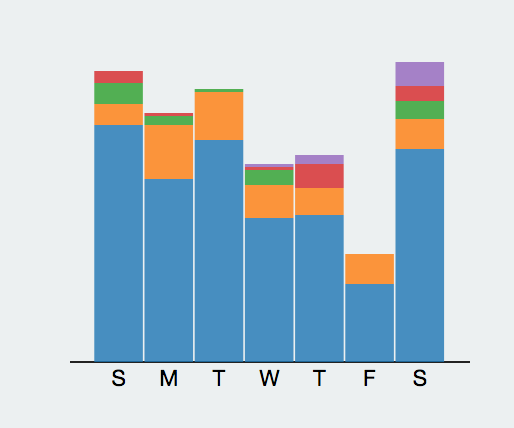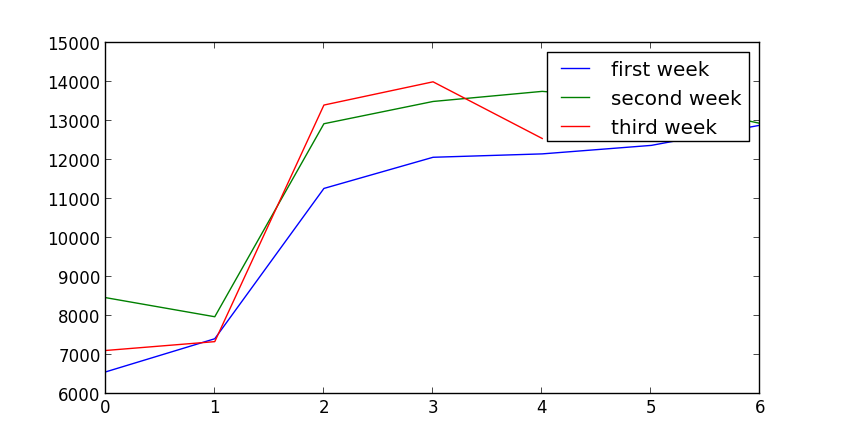Python Github用户数据分析二 每周分析
继上篇之后,我们就可以分析用户的每周提交情况,以得出用户的真正的工具效率,每个程序员的工作时间可能是不一样的,如

这是我的每周情况,显然如果把星期六移到前面的话,随着工作时间的增长,在github上的使用在下降,作为一个
a fulltime hacker who works best in the evening (around 8 pm).不过这个是osrc的分析结果。
python github 每周情况分析
看一张分析后的结果

结果正好与我的情况相反?似乎图上是这么说的,但是数据上是这样的情况。
data
├── 2014-01-01-0.json
├── 2014-02-01-0.json
├── 2014-02-02-0.json
├── 2014-02-03-0.json
├── 2014-02-04-0.json
├── 2014-02-05-0.json
├── 2014-02-06-0.json
├── 2014-02-07-0.json
├── 2014-02-08-0.json
├── 2014-02-09-0.json
├── 2014-02-10-0.json
├── 2014-02-11-0.json
├── 2014-02-12-0.json
├── 2014-02-13-0.json
├── 2014-02-14-0.json
├── 2014-02-15-0.json
├── 2014-02-16-0.json
├── 2014-02-17-0.json
├── 2014-02-18-0.json
├── 2014-02-19-0.json
└── 2014-02-20-0.json我们获取是每天晚上0点时的情况,至于为什么是0点,我想这里的数据量可能会比较少。除去1月1号的情况,就是上面的结果,在只有一周的情况时,总会以为因为在国内那时是假期,但是总觉得不是很靠谱,国内的程序员虽然很多,会在github上活跃的可能没有那么多,直至列出每一周的数据时。
6570, 7420, 11274, 12073, 12160, 12378, 12897,
8474, 7984, 12933, 13504, 13763, 13544, 12940,
7119, 7346, 13412, 14008, 12555python 数据分析
重写了一个新的方法用于计算提交数,直至后面才意识到其实我们可以算行数就够了,但是方法上有点hack
def get_minutes_counts_with_id(jsonfile):
datacount, dataarray = handle_json(jsonfile)
minuteswithcount = [(x, dataarray.count(x)) for x in set(dataarray)]
return minuteswithcount
def handle_json(jsonfile):
f = open(jsonfile, "r")
dataarray = []
datacount = 0
for line in open(jsonfile):
line = f.readline()
lin = json.loads(line)
date = dateutil.parser.parse(lin["created_at"])
datacount += 1
dataarray.append(date.minute)
f.close()
return datacount, dataarray
def get_minutes_count_num(jsonfile):
datacount, dataarray = handle_json(jsonfile)
return datacount
def get_month_total():
"""
:rtype : object
"""
monthdaycount = []
for i in range(1, 20):
if i < 10:
filename = 'data/2014-02-0' + i.__str__() + '-0.json'
else:
filename = 'data/2014-02-' + i.__str__() + '-0.json'
monthdaycount.append(get_minutes_count_num(filename))
return monthdaycount
接着我们需要去遍历每个结果,后面的后面会发现这个效率真的是太低了,为什么木有多线程?
python matplotlib图表
让我们的matplotlib来做这些图表的工作
if __name__ == '__main__':
results = pd.get_month_total()
print results
plt.figure(figsize=(8, 4))
plt.plot(results.__getslice__(0, 7), label="first week")
plt.plot(results.__getslice__(7, 14), label="second week")
plt.plot(results.__getslice__(14, 21), label="third week")
plt.legend()
plt.show()蓝色的是第一周,绿色的是第二周,蓝色的是第三周就有了上面的结果。
我们还需要优化方法,以及多线程的支持。
或许您还需要下面的文章:
围观我的Github Idea墙, 也许,你会遇到心仪的项目
comment
- 2025 年 AI 编程趋势:智能体 10 倍生产率放大下的“粪围”蔓延
- 2025 年 AI 驱动开发中的生产力与风险:10 倍悖论
- AutoDev Remote 编程智能体:你何必只让 AI 在白天分析需求、设计方案
- AutoDev 预上下文引擎:预生成代码语义化信息,构建 AI 编程的知识基座
- 两周 3 万行代码!我们的 7 个 AI “粪堆”求生编程实践
- AutoDev 智能开发驾驶舱|上下文驱动的 AI 编程开发者平台
- 预生成上下文:重构 RAG 的关键工程能力,构建企业级 AI 编程底座
- 预上下文生成:提升生成式 AI 代码生成效率的关键
- AI 友好架构:DevOps 平台 & 平台工程赋能 AI 自动编程
- AI 驱动的知识导航:通过平台工程提升开发者生产力
- opensuse (10)
- django (41)
- arduino (10)
- thoughtworks (18)
- centos (9)
- nginx (18)
- java (10)
- SEO (9)
- iot (47)
- iot system (12)
- RESTful (23)
- refactor (17)
- python (47)
- mezzanine (15)
- test (11)
- design (16)
- linux (14)
- tdd (12)
- ruby (14)
- github (24)
- git (10)
- javascript (52)
- android (36)
- jquery (18)
- rework (13)
- markdown (10)
- nodejs (24)
- google (8)
- code (9)
- macos (9)
- node (11)
- think (8)
- beageek (8)
- underscore (14)
- ux (8)
- microservices (10)
- rethink (9)
- architecture (37)
- backbone (19)
- mustache (9)
- requirejs (11)
- CoAP (21)
- aws (10)
- dsl (9)
- ionic (25)
- Cordova (21)
- angular (16)
- react (14)
- ddd (9)
- summary (9)
- growth (10)
- frontend (14)
- react native (8)
- serverless (32)
- rust (9)
- llm (8)

